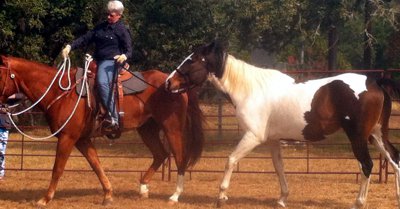Osteopathic Case Study: Cerise
Despite the hot summer I have continued to ride and train my mare, Cerise, in barrel racing. Since developing EPM last fall and being treated with the herbal product Sefacon this spring, Cerise has been getting stronger and stronger. About a month ago, Cerise set back at the trailer and broke her halter. Immediately afterward she started reaching around and trying to bite me when I put on her breast collar. At first I thought she was simply sore from setting back but the behavior continued. Once I got Cerise saddled she worked fine but did not have her usual pep. I suspected she was developing an ulcer so I started her on Succeed. She improved somewhat but still was not her usual healthy self. I adjusted her when I discovered that she had several ribs out but she still complained when I saddled her. She continued to work well once I got on. I knew she was trying to tell me something but I could not find the problem.
Last week I took her with me to an osteopathic training class. An osteopathic exam confirmed an ulcer but also suggested some internal problems with her ovaries. During the osteopathy course I learned that structural adjustments are not done until all internal problems have been corrected. Internal problems are suspected when three or more vertebral segments are fixated together. Cerise had a fixation on her sacrum and four lumbar vertebrae, as well as a blockage on her diaphragm. The diaphragm blockage was probably causing the ribs to be out of alignment and indirectly responsible for the ulcer, since when the diaphragm lacks full range of motion it affects the internal organs. In Cerise's case her diaphragm was fixated in expiration on one side and inspiration on the other side. This situation caused pressure on the organs on one side of the abdomen and tension on the other side from the pull of the connective tissues between the organs. A diaphragm blockage can also restrict the nerves and blood vessels that pass through it, which also affects the nutrition and nerve supply to the organs. The pectoral and abdominal muscles also become sore since they have to work harder to support the respiration.
When we palpated Cerise, we found a very sore left ovary. It was so sore, in fact, that when we touched it Cerise almost went down. I had worked on some chronic adhesions on Cerise's ovaries several months earlier and she had not been as sore then. I suspect that when she set back she tore some adhesions that I had not totally released, and this set up the pattern I was seeing. Once the adhesions on the ovary were released, Cerise relaxed noticeably. What was even more rewarding was that most of the osteopathic lesions released without any direct structural work since they were secondary to the internal problems. After several days off I rode Cerise and she did not try to bite me when I saddled her. However, I can tell she is still a bit sore and I am keeping her on the Succeed.
I am lucky that Cerise trusts me enough to let me know when she was hurting. Many horses have been punished for their attempts at communication so they simply work in pain. Other horses are less sensitive and will not seem to notice early signs of trouble but will have an unexplained decrease in performance. I am a firm believer in wellness exams for all horses, especially those in performance training.
Performance horses should be checked at least every few months and sometimes more frequently. I have really come to appreciate osteopathy because a good exam can not only detect problems but localize them as well. According to osteopathic theory, 80% of vertebral fixations are secondary to internal problems. Adjusting these fixations will give only brief improvement at best. At worst adjusting may interfere with the body's ability to compensate for the internal problem.
If you do not have access to a trained osteopath, you can still help your horse by keeping his non-fixated joints free and mobile. I suggest low force techniques such as network chiropractic, Equine Touch, Bowen or Cranial Sacral work. All these techniques will help your horse compensate so his vitality is not affected and in many cases keep him in work. The secret is regular body work so your horse is able to continue to compensate.
About the Author
Madalyn Ward, DVM, owns Bear Creek Veterinary Clinic in Austin, Texas. She is certified in Veterinary Homeopathy and Equine Osteopathy.
Memberships include American Veterinary Medical Association, American Association of Equine Practitioners, American Holistic Veterinary Medical Association, Texas Veterinary Medical Association and the Academy of Veterinary Homeopathy.
She has authored several books and publishes at her blog.
